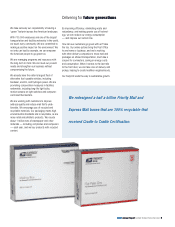US Postal Service 2007 Annual Report Download - page 19
Download and view the complete annual report
Please find page 19 of the 2007 US Postal Service annual report below. You can navigate through the pages in the report by either clicking on the pages listed below, or by using the keyword search tool below to find specific information within the annual report.
2007 Annual Report United States Postal Service | 19
Financial Section Part I
Should a state pass Do Not Mail legislation it would result in lost revenue
for the Postal Service. While none of the state bills passed during 2007,
in seven states the 2007 legislation automatically will be carried over
to the 2008 session. The bills in those seven states do not need to be
re-introduced in order to be considered.
Economic Risk
The demand for all postal services is heavily influenced by changes in the
economy. A slowdown in the economy would impact nearly every class
of mail negatively. In recent months a steep slump in housing prices,
challenging conditions in the financial and credit markets, and a recent
rise in oil prices have driven down consumer confidence. These conditions
may have an adverse impact on retail sales, investment, and employment.
Growth in retail sales, investment spending, and employment are all drivers
of mail demand.
Impact of Inflation on Revenue and Expense
P.L.109-435 is intended to benefit both residential and business custom-
ers by seeking to achieve predictable price increases tied to the rate of
inflation for services defined as mailing services (primarily First-Class Mail,
Standard Mail, and Periodicals). These services represent about 90% of
total revenues and about 86% of our attributable costs.
While the majority of our rates are now linked directly to general inflation,
our costs are not. In 2007, general inflation as measured by CPI-U was
2.8% compared with postal resource price inflation of 3.7%. Postal costs
are heavily concentrated in wages, employee and retiree benefits, and
transportation. They are significantly impacted by legislatively-imposed
expenses and by the continuous expansion of our delivery network. Under
current conditions, we believe that both volume and revenue growth, along
with increasing productivity improvements, will be required to address the
challenge presented by the regulatory price cap.
The labor contracts with three of our four largest unions currently include
provisions granting a cost of living allowances (COLAs). These recently ne-
gotiated contracts expire in 2010 or 2011. One contract with the NRLCA is
in interest arbitration. Under current contract provisions, COLAs are linked
to the Consumer Price Index (CPI) and are granted semiannually. Employee
compensation represents a significant portion of our annual expenses;
therefore, an increase in the CPI greater than had been incorporated into
our financial plans could adversely affect financial results.
We estimate that an increase in the CPI of 0.5% would cause an annualized
increase in our COLAs of about $100 million.
Fuel Price Risk
Fuel prices are a significant part of our expenses. We are exposed to
changes in commodity prices primarily for diesel fuel, unleaded gasoline
and aircraft fuel for transportation of the mail and natural gas for heating
facilities. A 1.0% change in fuel and natural gas costs would result in a $24
million increase in expense. We currently do not use derivative commodity
instruments to manage the risk of changes in energy prices.
Technology
We rely extensively on technology to operate our systems for processing
and delivering mail. Our intranet is the largest maintained by any organiza-
tion in the world. Any significant failure of these systems could cause delays
in the processing and delivering mail, which could damage our reputation,
result in loss of business and increase our costs of operation.
Privacy
We receive a variety of private information from our customers, such as
address change data. We have implemented a number of safeguards
intended to protect the confidentiality of data that we obtain. Any significant
violation of the privacy of our data could damage our reputation and result
in loss of business.
Biohazards
Although we have implemented extensive emergency preparedness
measures to keep the mail, postal employees and postal customers safe
from harm due to biohazards that could be introduced into the mailstream,
we must continue to be vigilant about possible biohazard threats. If a new
biohazard were to arise and our measures were not sufficient to contain
or otherwise mitigate the threat, our services could be disrupted. This
could adversely affect our revenues, and we could be required to make
substantial expenditures to address the threat, which could also adversely
affect our costs of operation and financial condition.
Security
We may be required to comply with additional security requirements
contained in legislation and regulations adopted to address threats to
national security. For example, on August 3, 2007, the Implementing
Recommendations of the 9/11 Commission Act of 2007 (P.L.110-53) be-
came effective. This Act requires the Transportation Security Administration
(TSA) to impose additional screening requirements for cargo transported
on passenger aircraft. The TSA has not yet made clear whether or how
it will apply to the transportation of mail. Accordingly, we cannot predict
the impact of the Act. Depending upon how the Act and other security
requirements are implemented, we could be required to make significant
expenditures, which could have a material adverse effect on our results of
operation and/or financial condition.
Item 2 – Properties
Real Estate
Our facilities range in size from 60 square feet to 34 acres under one roof,
and support retail, delivery, mail processing, maintenance, administrative,
and support activities.
Real Estate Inventory 2007 2006
(Actual numbers)
Leased Facilities 25,450 25,567
Owned Facilities 8,487 8,437
GSA / Other Government Facilities 381 408
Total Real Estate Inventory 34,318 34,412
Annual Rent paid to lessors
(Dollars in millions)
$ 973 $ 1,002
























